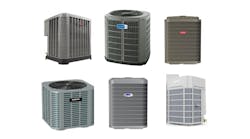In coastal areas of the U.S., it’s common to have houses built over closed crawlspaces. This is partly because the water table is often so high that if you build a basement under a house, it’s like having an indoor swimming pool. About 30% of all new houses built in the southern part of the U.S. are built on crawlspaces. In South Carolina, the number is more like 70%.
The trouble with crawlspace construction is that it’s more likely to have mold and wood rot problems than other types of construction. Both of these problems are types of fungal growth.
If mold is growing on the wood in the crawlspace, even in spots, you have problems. If it’s a white mold, it’s usually a surface mold, but consider it a sign that humidity levels are too high. White mold usually doesn’t cause real damage to the wood; however, if you see black or brown mold, that’s rot fungus: Structural damage is occurring that could require replacement of wood members. Immediate action is required!
If you find something that looks like roots going from the ground into the wood, that’s Poria fungus. It’s very bad, and can completely destroy a house in just a few months. Cut the roots and immediately get expert attention.
Wood rot only occurs when the moisture content is above the fiber saturation point, about 27% to 28% wood moisture content. In order to keep this in perspective, consider the following: Fresh-cut wood is typically around 200% moisture; that is, twice as much water as wood. Kiln-dried wood has seven to 10% wood moisture content. Air-dried wood has a typical moisture content of 19%, but that varies with the relative humidity (RH). With an RH of 10% and normal temperatures, you can expect wood moisture content to be around 3%. With a relative humidity of 100%, you can expect a wood moisture content of 23 to 26%.
The 28% wood moisture content necessary for rot to occur doesn’t come about from just high humidity. Water has to make contact with the wood before the wood rots. Any time the relative humidity is over 70%, you can get spot condensate because temperatures vary throughout a crawlspace.
Bugs, mold, and rot affect wood in the crawlspace. All three have the same basic requirements: food, water or humidity above 70%, temperatures between 40F and 120F, air, and, in some cases, security or protection from being disturbed.
Mold spores and a wood moisture content above just 20% are required for mold to start.
Some types of decay fungi can cause a 60% strength loss in wood in just four to six weeks.
Termites also are active only in moist wood.
The Fix
The most common fix for a humid crawlspace in dry climate areas is to add about one square foot of net free crawlspace vent area for every 150 sq.ft. of crawlspace area if no plastic is laid on the ground in the crawlspace. If plastic is laid in the crawlspace, you only need one square foot of net free crawlspace vent area for every 1,500 sq.ft. of crawlspace area.
Note that most crawlspace vents, also called brick vents, have only 60 to 75 sq.in. of free area, or about .5 sq.ft net free area each. Building codes may dictate the number of crawlspace vents installed in a house and whether they may be permanently sealed. Check with your local building department about code requirements.
In areas where there’s very high outside humidity during the summer, ventilating the crawlspace can bring more moisture into the space than it removes.
Soil evaporation also can be a significant source of crawlspace moisture. In some areas, the water table is within three feet of ground level. With a 3-ft. water table, the ground can evaporate up to 12 gal. of water/day in a 1,000 sq.ft. crawlspace area. By adding 6 mil plastic overlapped at the seams, this is reduced to less than 1 gal./day in the same area.
Determining the Fix
Here’s how to determine how much moisture is introduced into tile crawlspace of a 1,500 sq.ft. house with a three-foot-high crawlspace having a 4,500 cu.ft. volume during a 24-hour period. The average temperature in the crawlspace is 72F at 85% RH. Consider the following formula:
1) Exhaust air: Assume one air change/hr. (1 ACH).
Vcs*24/8.33*ACH/SV*AH = gal./day, or
4,500*24/8.33*-1/13.7*.0142 = -13.4 gal./day
Where:
*Vcs is crawlspace volume
*(24/8.33) is the hours in a day
divided by lbs. of water/gal.
(This converts lbs./hr. to gals./day.)
*ACH is air changes/hr.
*SV is the specific volume of the air.
*AH is the absolute humidity in lbs. of water/lb. of dry air.
The specific volume of the air and the absolute humidity can be plotted on a psychrometric chart. In order to got these values, you must measure the wet bulb and dry bulb temperatures in the crawlspace, then plot those values on the psychrometric chart. You’ll have to take several readings and plot the averages. If your psychrometric chart shows absolute humidity in grains instead of decimal fractions of a pound, divide the grains of water by 7,000. This is because there are 7,000 grains of water/lb.
2) Makeup air: Assume outdoor air at 94F at 45% RH.
4,500*24/8.33*1/14.3*.0155 = 14.l gals./day
3) Soil evaporation: Assume 12 gals/1,000 sq.ft.
12*1.5 = 18 gals./day
So:
1) = -13.4 gallons per day
2) = + 14. 1 gallons per day
3) = + 18.0 gallons per day
Total change in crawlspace moisture is + 18.7 gals./day
As you can see, ventilation hasn’t reduced moisture levels in the crawlspace; it’s actually made it wetter. If fans are added, more air is moved into the crawlspace, and the added moisture increases the humidity.
If 6 mil. plastic is laid down in the crawlspace, ground evaporation is reduced to about .5 gals. or less/day/
1,000 sq.ft. of crawlspace. This assumes that the plastic has 100% coverage, with six to 12 inches of overlap at the seams. It’s also helpful, in very humid areas, to turn the plastic up 12 to 18 inches at the foundation walls. This will reduce the moisture infiltration from outside air through the foundation wall. Be careful to protect the plastic from damage.
Pest control personnel, the cable TV installer, and the plumber can have reasons to be in the crawlspace. If they disturb the seams or tear the plastic, soil evaporation can rise again.
If the same process is used to determine how much water is added to a crawlspace with plastic ground cover, consider:
The amount exhausted stays the same: 1) = -13.4 gals./day
The amount from makeup air stays the same: 2) = + 14. 1 gals./day
The amount from soil evaporation is reduced: 3) = + 0.75 gals./day
Total change in crawlspace moisture= + 1.45 gals./day
By adding a vapor retarder to the ground in the crawlspace, the moisture added to the crawlspace is reduced by 13.5 gals. in our sample house. The 1.45 gals. of water remaining is equivalent to 5. 8 quarts or 11.6 pints of water per day, which can be removed by mechanical means.
A Mechanical Solution
Here’s a better way to reduce damage to the wood in a damp crawlspace occurring in a high-humidity area.
Dig a hole in the lowest spot in your crawlspace and put a perforated 5 gal. bucket ( or sump) in it. Surround the bucket with gravel or septic drain field cloth.
Dig trenches in the crawlspace ground and lay slotted drainage pipes in them, pitched down to the sump pit. Cover the pipes with the soil you took out to make the trenches. Put a sump pump into the bucket and pipe the discharge line well away from the house. Do this step only if the ground in your crawlspace is damp or if there’s condensate forming on the ducts or floor joists.
Lay plastic sheets in your crawlspace, covering the ground completely. This will reduce evaporation of water out of the ground. Use at least 6 mil plastic and overlap the joints by 12 inches.
Cover the bottom inside wall of the crawlspace as far up as possible. We’ve found that water sometimes condenses in the crawlspace above the plastic. You can make small holes in the plastic sheeting at the low points to allow the water to drain into the ground below. This won’t add significantly to the evaporation problem.
Insulate all ducts in the crawlspace or replace them, making sure the new ones are sealed and well-insulated. Another option is to move the duct system to the attic, which may is the best solution because even insulated ducts can reduce the temperature in the crawlspace, raising the
relative humidity. Ducts can also sweat, adding water to the crawlspace. If you must have ducts in the crawlspace, add more insulation to them. Professor Barbara Griffin of Clemson University
recommends four inches of insulation to keep ducts from sweating in crawlspaces in South Carolina.
Sealing ducts helps because duct leakage in the crawlspace can cause pressure imbalances in the house and crawlspace. If the supply duct leaks, the house pressure becomes negative with respect to the crawlspace, and air can be pulled through cracks and other openings into the house. Return duct leaks move air in the opposite direction. In both cases, mold spores and other contaminants can be introduced to the house, affecting air quality in the living space.
Seal all openings, both new and existing, between the house and crawlspace. Air inflow is determined by pressure differential and hole size. If you make a hole, seal it. Unwanted air flow can have unknown side effects. Install vapor retarders between the living area and the crawlspace. Note that plastic and kraft paper are often called vapor barriers. They really don’t stop the flow of moisture; they just slow it; therefore, it’s more correct to call them vapor retarders.
Heat flows from areas of high temperature to areas of low temperature. Pressure flows from high intensity to low intensity. Moisture follows the same pattern. If there’s high absolute humidity in the crawlspace and low absolute humidity in the living area, moisture will be drawn from the high humidity area into the low humidity area. The vapor retarder will not stop the flow; therefore, proper humidity control in the living area will help alleviate the problem.
Make sure the air conditioner is properly sized, as over-sized equipment contributes to poor humidity control. Make sure airflow is between 350 and 400 cfm/ton.
Too much airflow can leave too much humidity in the air. Make sure the indoor blower is left on Automatic. Continuous blower operation causes re-evaporation of air from the coil and condensate pan when the compressor shuts off.
Consider the use of a variable speed indoor blower. Most have enhanced humidity control modes that run the blower at a reduced speed for the first 5 to 10 minutes. This allows the indoor coil to get colder than normal, which enhances humidity removal.
Close or cover crawlspace vents. Install a dehumidifier in the crawlspace and run the drain outside, piped as far away from the house as practical. If you installed a sump pump in the crawlspace, drain it into the sump pit.
Make sure the condensate drain line from the air conditioner indoor unit doesn’t drain into the crawlspace and that the drain line is kept clear. If the condensate drains into the crawlspace, a sump or condensate pump should bc installed.
In some cases, a new condensate drain line can be run with proper downward pitch all the way to the outside. The drain should terminate above grade outside so the line doesn’t clog.
Make sure the dryer vent doesn’t terminate in the crawlspace. Drying a load of clothes can produce 4 to 6 pints of water vapor. If the house uses a gas dryer, the products of combustion will add even more moisture to the space.
Plumbing leaks can be a major source of crawlspace moisture. They should be fixed as soon as possible because they can cause the wood to soften, making it easier for mold and rot to destroy. Make sure the relief valve and drain pan drain line from the water heater are piped outside or into the sump pit.
In humid areas, ventilating the crawlspace is only effective in the spring and fall when the absolute humidity of the air outside the crawlspace is lower than the absolute humidity of the air inside it. In coastal areas, that almost never happens in the summer.
As a general rule, if it’s above 75F outside, there’s more moisture in the outside air than in the 70 to 75F crawlspace air; therefore, if you ventilate the crawlspace, you’re bringing more moisture into the crawlspace than you’re removing. Anytime you drop the air temperature by 20 degrees, the relative humidity approximately doubles. When it gets to 95F outside and that air is brought into the 75F crawlspace, the relative humidity doubles. If it’s 60% RH outside, the relative humidity in the crawlspace is at the dew point. At dew point conditions, water vapor turns back to liquid.
If exhaust fans are running in the crawlspace, you can also suck conditioned air out of the house into the crawlspace through cracks, making it colder in the crawlspace. This can increase condensation in the crawlspace, making the problem even worse.
If a fan must be used to ventilate the crawlspace, install it in the attic and blow hot attic air into the crawlspace. Making the crawlspace warmer drops the level of relative humidity because air can hold more moisture at higher temperatures. Doing this requires a space where a duct can run from the attic to the crawlspace. Make sure to install a fan and duct large enough to warm the entire crawlspace, remembering that this will increase the air conditioning load and power consumption slightly.
In one house under study by Clemson University, an attic-mounted fan was used to ventilate a basement and crawlspace, each under about half of the house. Operating the fan for four hours a day was enough to dissipate smells and excess moisture.Depending on conditions, 12 to 30 air changes/hr. of the crawlspace air were required. This is the only house that I am aware of that uses attic air to dehumidify a crawlspace, so this method is still experimental. You’ll need to use trial-and-error to determine how to size the fan and how much to run it.
Try to avoid the use of toe space grilles in kitchens and bathrooms above the crawl space. When cold air is blown into the space between the floor and the cabinet base, the temperature of all the flooring under the cabinet drops to about the supply air temperature. I’ve been in a number of crawlspaces where the plywood under the cabinets was black and mushy from rot, and I’ve seen hardwood floors buckle next to toe space grilles.
Repairs to hardwood floors can get very expensive, especially if they need to be done every year. Icynene insulation can be sprayed on wood under toe space grilles in the crawlspace to stop condensation and seal the wood. Be sure to seal around the duct penetrating the floor to reduce unwanted air movement.
Not all solutions to crawlspace moisture problems are in the domain of the HVAC contractor. Proper construction of the house is very important to successfully eliminate crawlspace moisture problems. Remember that the house is a system: Everything has to work together properly in order to eliminate damp crawlspaces.
Add gutters and downspouts to your house to carry water away from the house. Divert the water from the downspouts as far away from your house as is practical. Putting oversized splash blocks at the bottom of the downspouts helps, but piping them at least 10 feet away is preferable.
Insulate your floor to reduce condensation on the wood. If you have trusses instead of floor joists, make sure the insulation is up against the floor docking. Using Icynene foam insulation is better than using fiberglas batts. If the insulation is at the bottom of the floor truss, gaps in the insulation allow moisture-laden air to get above the insulation to condense on the underside of the floor and drip on the insulation. Wet insulation rarely does any good.
The exception is expanded foam insulation. Icynene foam insulation can be sprayed on the underside of the floor facing the crawlspace, providing both insulation and a vapor barrier. It can also seal cracks between the house and the crawlspace, reducing unwanted airflow between the two areas.
The ground should slope away from the foundation of the house so water does not puddle near the foundation when it rains. If the water table is high, you may want to install a French drain, provided there is lower ground nearby where you can pipe away the water that was collected.
Make the crawlspace as high as possible, at least 18 inches high. Some studies show the minimum height should be 24 inches. If ducts or other obstructions to free air movement within the crawlspace are present, allow several inches above and below the duct for air circulation.
The ground level in the crawlspace should be higher than the ground outside. Problems occur when the crawlspace is lower than the exterior grade. Make sure the ground in the crawlspace is highest at the center so water drains toward the outer edges. If there is standing water in the crawlspace, refer to the sections of this article on sump pumps and dehumidifiers.
Be careful about hauling sand into a damp crawlspace because it reduces the height of the crawlspace. If the ground underneath is wet, fine sand tends to wick water to the top. Using pea gravel instead of sand allows the large spaces between pieces of gravel to break up the capillary action and reduce dampness in the top layers. Lay plastic on top of the gravel and pour lightweight concrete over the plastic. This will protect the plastic, which can be disturbed or damaged by people crawling over it during maintenance.
Conclusion
Ventilation, whether by natural draft or mechanical means, is only effective if the makeup air has a lower absolute humidity than the crawlspace air. In coastal and other humid areas, it’s often more effective to use dehumidifiers and sump pumps to remove excess moisture from damp crawlspaces.
Much of the information for this article was provided by Dr. Craig DeWitt, the late Dr. Richard Spray, and Barbara Gniffin, retired, all of Clemson University. Dr. Dewitt can be reached at 864/656-1419 or by writing to Craig A. DeWitt, Ph.D., P.E., Clemson University, SC Institute for Energy Studies, Box 345180, 386-2 College Ave., Clemson, SC 29634-5180.
Kevin O’Neill is vice president of HVAC at Carolina Cooling & Plumbing, Inc., 1294 Surfside Industrial Park, Surfside Beach, SC 29575. He is a Certificate Member of RSES and has 23 years of industry experience. Call him at 843/238-5805.








